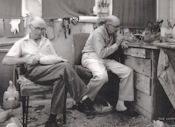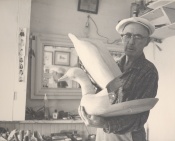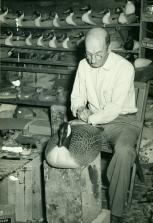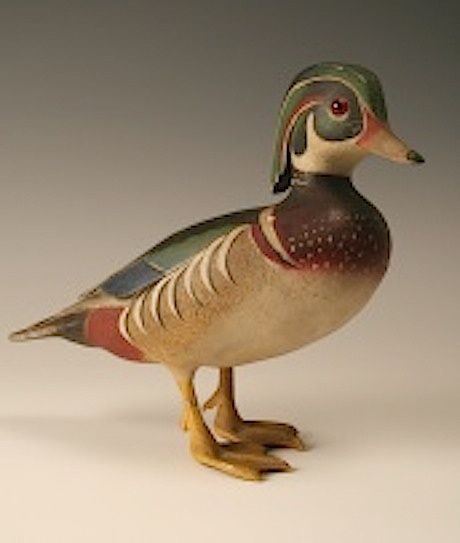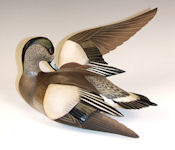A Decoy Corner Article by Bruce Urben, President
All photos courtesy wardmuseum.org
While I have tried to focus on Wisconsin decoy carvers and factory decoys produced and used in the Midwest in past articles in the “Decoy Corner”, it occurred to me that it would be inappropriate not to highlight two of the most recognized and talented carvers ever known-the Ward Brothers of Crisfield, Maryland.
Steven W. Ward was born in 1895 and his brother, Lemuel T. Ward, was born in 1896 in Crisfield, Maryland. Crisfield is about halfway down the Chesapeake Bay on the eastern shore near the Maryland/Virginia state line. Both brothers were born in Crisfield and both died there. The Ward brothers, as they were known, were barbers by trade. It was known that Lem never enjoyed barbering but it was the only way he could make a living because of a crippling birth defect.
They both became bored in their barber shop while waiting for customers and started to whittle wood decoys from cedar blocks. While Crisfield was a waterman’s town, there was a huge need for hunting decoys as duck hunting on the Chesapeake was phenomenal. Market hunting for ducks was practiced routinely by many on the Chesapeake and soon the brothers’ barber shop floor was filled with decoys. People began to visit their shop just to see what they were working on and to purchase their decoys. The extra money was a great help during the Great Depression. In 1933, haircuts were 15 cents and decoys sold for a dollar and twenty five cents each!
Both Steve and Lem were avid waterfowlers. Steve made his first decoy in 1907 at the age of 12 – a blackduck hacked out of an old telephone pole with a hatchet. Lem made his first decoy in 1918, a big headed bluebill with fat jaws. Both were used in their own hunting rigs.
In 1926, the brothers formed a partnership after their father passed away and agreed to make decoys when barbering was slow. Steve did most of the carving and Lem did most of the painting, however, they both were credited with decoys produced individually as well. Lem was the perfectionist, he was never satisfied with his painting and was always improving the colors and detail on his decoys. Initially, they produced about 100 decoys each year, many were already sold before they were completed. By 1959 they were producing thousands of decoys each year. Unfortunately, many of the early decoys were never signed by the brothers.
Even though many were unsigned, it was easy to identify a Ward decoy. Ward decoy heads were perfect replicas of ducks as they saw them. Early heads were attached looking straight forward, but after the 1930’s most were turned left or right to give a more natural appearance. All Ward decoys have flat bottoms and the bodies ranged from heart shaped to oval. The tails on their decoys varied greatly; upswept, downswept and flared. Most of their decoys were fitted with keels about 1 inch wide and 1-1/4 inches deep with a hole in the front for the mooring line. Their decoys were made from cedar (old telephone poles) and juniper, and their later decoys were hollowed exclusively.
What set the Ward decoys apart was their superb painting schemes. The Wards were known for their outstanding artistic ability and used unique painting techniques, including stippling. Their painting has been called “impressionistic”, as each decoy was unique with its own feathering scheme. They used sharp-edged styling and always included a beautiful speculum, even though it was seldom seen on live birds.
Clearly, Ward gunning decoys were works of art and are now considered “decorative” by many collectors. Their carvings turned to pure decorative in the 1960’s and are described by many as the most beautiful decoys made – floating sculptures!
The Wards made thousands of decoys during their 60-70 years of carving, which included all species, including shorebirds! They were both known in Crisfield as Wildfowl “Counterfeiters in Wood”. Steve Ward passed away in 1976 and Lem continued carving up until his death in 1984.
To recognize the Ward brothers’ work, the Ward Museum of Wildfowl Art in Salisbury, Maryland opened in 1992 as part of Salisbury University and is the largest collection of Wildfowl art in the World. You can see many of the Ward’s decoys there, as well as a replica of their shop at the museum.
As expected, Ward decoys are very collectible and many have been sold at decoy auctions. Most recently, at the Guyette & Deeter spring auction in April of 2019, a Ward hen mallard decoy was sold for $30,680. While I am sure you will not find a Ward decoy at your local rummage sale or hometown auction, they are available on the secondary market and can be seen in many museums.
I had the opportunity to visit the Ward Museum this past April while I was in Ocean City, Maryland at the Ward World Championship Decoy Carving Contest. Just to see the Ward brothers’ decoys was a treatm and most could still compete with any contemporary carver of this time! It is appropriate that the World Championship Decoy Carving Contest is held in Maryland and is named in honor of the Ward Brothers! This year was the 49th anniversary of the Ward World Championships with over 1200 competitors from all over the World.
I was honored to be able to enter several of my own hand carved decoys in the Lem and Steve Hunting Rig Competition at the World Championships this last April. What thrilled me even more was that I was awarded first and third place ribbons for both rigs that I entered. I guess that helps me connect just a little with two of the most famous and respected carvers in the world, Lem and Steve Ward-Wildfowl Counterfeiters in Wood.
Check out this YouTube video documentary on the Wards:

